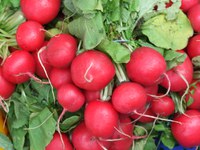Prairie Fare: Gardening Provides More Than Healthful Food
(Click an image below to view a high-resolution image that can be downloaded)
By Julie Garden-Robinson, Food and Nutrition Specialist
NDSU Extension Service
“She weeded the garden in her Sunday clothes without getting dirty,” my husband announced to some of our friends.
They looked at me to see what I was wearing. I think they glanced to see whether I had the “tell-tale dirty knees” of a gardener. My clothes and knees were clean.
Why was I gardening in my good clothes, anyway? Because now I can.
We have had a backyard garden for many years, but last year, the weeds won. We went on a short vacation and found a thick carpet of weeds when we returned home.
Then Jake the dachshund sneaked into our garden over a fence to nab a tomato. The fence was designed to exclude rabbits (but, obviously, not dogs). When he leaped out of the garden, he injured himself and ended up on “crate rest” for two months.
Between the weeds and nursing a sick dog, we gave up on last year’s garden.
This year, weeding is a lot easier because my garden beds are elevated 3 feet from ground level. My husband built raised beds after combining several ideas on YouTube. We can plant, pluck the offending weeds and harvest without kneeling or bending. When we are older, we will appreciate the ease of gardening in raised beds, too.
Even better, the bumper crop of bunnies hopping around our neighborhood would have to pole vault into our garden to chomp on my beans and lettuce. I wouldn’t put it past some of the fearless rabbits (or Jake) to grab a stick and try.
My family is amused by my frequent trips to check our garden beds. I find gardening to be very relaxing. Many published studies have shown numerous health benefits associated with gardening activities.
Gardens can promote several healthy behaviors. Home gardens provide us with an immediate source of fresh, highly nutritious food. After tending a garden for weeks or months, you do not want all this delicious, fresh food to go to waste, so you eat it, share it or preserve it.
When you gather fresh vegetables and immediately prepare them, you are getting a flavorful, colorful source of nutrition. Eating foods grown close to home means they will retain most of their nutrients.
Lettuce and radishes are among the first vegetables we can harvest. Lettuce and radishes can be prepared for eating in minutes. Because of their high water content, they are very low in calories. Visit https://www.ag.ndsu.edu/food and click on “Field to Fork” for a variety of ways to use and preserve fresh produce this season.
If you have had a stressful day, getting back to nature may help you feel better. Pull some weeds and water your plants, and your tension may float away.
In one study that compared the effect of gardening vs. reading on reducing stress, gardening was found to be more effective. The gardeners were in a better mood, and the researchers also found that the gardeners’ levels of stress hormones were lower.
If you are seeking to increase the amount of physical activity that you do, gardening and yardwork may be just what the doctor ordered. Get out a hoe and some pruning shears, and you may tone some muscles as you do this low-impact activity.
If you are inspired to head outdoors and befriend some foliage, be sure to remember a couple of safety tips. Because mosquitoes and ticks can carry disease, protect yourself with proper clothing such as long-sleeved shirts and pants. Wear a repellent containing DEET. Don’t forget to apply SPF 30 or higher sunscreen. Drink plenty of water and take breaks in the shade.
Enjoy the harvest and be a little adventurous with radishes. Their peppery flavor makes a tasty addition to salads or relish trays. If radishes are too zesty for you, try roasting them. When radishes are heated, they become much milder and sweeter.
After rinsing and trimming radishes, slice them in half, and add some salad oil and minced garlic. Roast them skin side up for about 10 minutes in a 450 F oven, or until tender.
Here’s another version of roasted radishes from Oregon State University. This recipe also provides a tasty way to enjoy some fresh-from-the-garden peas. Of course, either of these recipe ideas can be prepared from store-purchased produce, too.
Roasted Radishes With Green Peas
1 bunch large radishes (approximately 10 radishes)
2 tsp. salad oil
1/4 teaspoon salt
1/4 teaspoon pepper
1 c. peas (fresh or thawed from frozen)
1 Tbsp. fresh lemon juice
1 tsp. dried dill (optional)
Heat oven to 450 F. Rinse, trim and cut radishes into quarters. In a rimmed baking sheet, mix radishes with oil, salt and pepper. Place baking sheet in oven and roast for 10 minutes. Remove baking sheet from oven and sprinkle peas over the radish mixture. Return the baking sheet to the oven and roast just until peas are heated through. Remove from oven and sprinkle with lemon juice and (if desired) dill.
Makes three servings, about 1/2 cup per serving. Each serving has 60 calories, 2 grams (g) fat, 3 g protein, 8 g carbohydrate, 3 g fiber and 260 milligrams sodium.
(Julie Garden-Robinson, Ph.D., R.D., L.R.D., is a North Dakota State University Extension Service food and nutrition specialist and professor in the Department of Health, Nutrition and Exercise Sciences.)
NDSU Agriculture Communication - June 22, 2017
| Source: | Julie Garden-Robinson, 701-231-7187, julie.garden-robinson@ndsu.edu |
|---|---|
| Editor: | Ellen Crawford, 701-231-5391, ellen.crawford@ndsu.edu |



